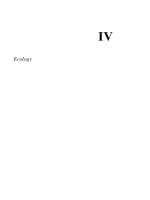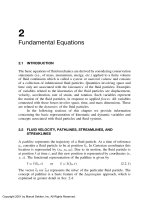Hibbeler Engineering Mechanics (Solutions Manual) Statics 12th Edition Engineering Mechanics chapter 2.PDF
Bạn đang xem bản rút gọn của tài liệu. Xem và tải ngay bản đầy đủ của tài liệu tại đây (12.35 MB, 114 trang )
2 Solutions 44918
1/21/09
12:01 PM
Page 7
© 2010 Pearson Education, Inc., Upper Saddle River, NJ. All rights reserved. This material is protected under all copyright laws as they currently
exist. No portion of this material may be reproduced, in any form or by any means, without permission in writing from the publisher.
•2–1. If u = 30° and T = 6 kN, determine the magnitude
of the resultant force acting on the eyebolt and its direction
measured clockwise from the positive x axis.
y
T
u
x
45Њ
8 kN
7
2 Solutions 44918
1/21/09
12:01 PM
Page 8
© 2010 Pearson Education, Inc., Upper Saddle River, NJ. All rights reserved. This material is protected under all copyright laws as they currently
exist. No portion of this material may be reproduced, in any form or by any means, without permission in writing from the publisher.
2–2. If u = 60° and T = 5 kN, determine the magnitude
of the resultant force acting on the eyebolt and its direction
measured clockwise from the positive x axis.
y
T
u
x
45Њ
8 kN
8
2 Solutions 44918
1/21/09
12:01 PM
Page 9
© 2010 Pearson Education, Inc., Upper Saddle River, NJ. All rights reserved. This material is protected under all copyright laws as they currently
exist. No portion of this material may be reproduced, in any form or by any means, without permission in writing from the publisher.
2–3. If the magnitude of the resultant force is to be 9 kN
directed along the positive x axis, determine the magnitude of
force T acting on the eyebolt and its angle u.
y
T
u
x
45Њ
8 kN
9
2 Solutions 44918
1/21/09
12:01 PM
Page 10
© 2010 Pearson Education, Inc., Upper Saddle River, NJ. All rights reserved. This material is protected under all copyright laws as they currently
exist. No portion of this material may be reproduced, in any form or by any means, without permission in writing from the publisher.
*2–4. Determine the magnitude of the resultant force
acting on the bracket and its direction measured
counterclockwise from the positive u axis.
F2 ϭ 150 lb
v
30Њ
u
30Њ
45Њ
F1 ϭ 200 lb
10
2 Solutions 44918
1/21/09
12:01 PM
Page 11
© 2010 Pearson Education, Inc., Upper Saddle River, NJ. All rights reserved. This material is protected under all copyright laws as they currently
exist. No portion of this material may be reproduced, in any form or by any means, without permission in writing from the publisher.
•2–5. Resolve F1 into components along the u and v axes,
and determine the magnitudes of these components.
F2 ϭ 150 lb
v
30Њ
u
30Њ
45Њ
F1 ϭ 200 lb
11
2 Solutions 44918
1/21/09
12:01 PM
Page 12
© 2010 Pearson Education, Inc., Upper Saddle River, NJ. All rights reserved. This material is protected under all copyright laws as they currently
exist. No portion of this material may be reproduced, in any form or by any means, without permission in writing from the publisher.
2–6. Resolve F2 into components along the u and v axes,
and determine the magnitudes of these components.
F2 ϭ 150 lb
v
30Њ
u
30Њ
45Њ
F1 ϭ 200 lb
12
2 Solutions 44918
1/21/09
12:01 PM
Page 13
© 2010 Pearson Education, Inc., Upper Saddle River, NJ. All rights reserved. This material is protected under all copyright laws as they currently
exist. No portion of this material may be reproduced, in any form or by any means, without permission in writing from the publisher.
2–7. If FB = 2 kN and the resultant force acts along the
positive u axis, determine the magnitude of the resultant
force and the angle u.
y
FA ϭ 3 kN
u 30Њ
B
u
FB
13
x
A
2 Solutions 44918
1/21/09
12:01 PM
Page 14
© 2010 Pearson Education, Inc., Upper Saddle River, NJ. All rights reserved. This material is protected under all copyright laws as they currently
exist. No portion of this material may be reproduced, in any form or by any means, without permission in writing from the publisher.
*2–8. If the resultant force is required to act along the
positive u axis and have a magnitude of 5 kN, determine the
required magnitude of FB and its direction u.
y
FA ϭ 3 kN
u 30Њ
B
u
FB
14
x
A
2 Solutions 44918
1/21/09
12:01 PM
Page 15
© 2010 Pearson Education, Inc., Upper Saddle River, NJ. All rights reserved. This material is protected under all copyright laws as they currently
exist. No portion of this material may be reproduced, in any form or by any means, without permission in writing from the publisher.
•2–9. The plate is subjected to the two forces at A and B
as shown. If u = 60°, determine the magnitude of the
resultant of these two forces and its direction measured
clockwise from the horizontal.
FA ϭ 8 kN
u
A
40Њ
B
FB ϭ 6 kN
15
2 Solutions 44918
1/21/09
12:01 PM
Page 16
© 2010 Pearson Education, Inc., Upper Saddle River, NJ. All rights reserved. This material is protected under all copyright laws as they currently
exist. No portion of this material may be reproduced, in any form or by any means, without permission in writing from the publisher.
FA ϭ 8 kN
2–10. Determine the angle of u for connecting member A
to the plate so that the resultant force of FA and FB is
directed horizontally to the right.Also, what is the magnitude
of the resultant force?
u
A
40Њ
B
FB ϭ 6 kN
2–11. If the tension in the cable is 400 N, determine the
magnitude and direction of the resultant force acting on
the pulley. This angle is the same angle u of line AB on the
tailboard block.
y
400 N
30Њ
u
B
x
400 N
A
16
2 Solutions 44918
1/21/09
12:01 PM
Page 17
© 2010 Pearson Education, Inc., Upper Saddle River, NJ. All rights reserved. This material is protected under all copyright laws as they currently
exist. No portion of this material may be reproduced, in any form or by any means, without permission in writing from the publisher.
*2–12. The device is used for surgical replacement of the
knee joint. If the force acting along the leg is 360 N,
determine its components along the x and y ¿ axes.
y¿
y
10Њ
x¿
x
60Њ
360 N
17
2 Solutions 44918
1/21/09
12:01 PM
Page 18
© 2010 Pearson Education, Inc., Upper Saddle River, NJ. All rights reserved. This material is protected under all copyright laws as they currently
exist. No portion of this material may be reproduced, in any form or by any means, without permission in writing from the publisher.
•2–13. The device is used for surgical replacement of the
knee joint. If the force acting along the leg is 360 N,
determine its components along the x ¿ and y axes.
y¿
y
10Њ
x¿
x
60Њ
360 N
18
2 Solutions 44918
1/21/09
12:01 PM
Page 19
© 2010 Pearson Education, Inc., Upper Saddle River, NJ. All rights reserved. This material is protected under all copyright laws as they currently
exist. No portion of this material may be reproduced, in any form or by any means, without permission in writing from the publisher.
2–14. Determine the design angle u (0° … u … 90°) for
strut AB so that the 400-lb horizontal force has a
component of 500 lb directed from A towards C. What is the
component of force acting along member AB? Take
f = 40°.
400 lb A
u
f
B
C
2–15. Determine the design angle f (0° … f … 90°)
between struts AB and AC so that the 400-lb horizontal
force has a component of 600 lb which acts up to the left, in
the same direction as from B towards A. Take u = 30°.
400 lb A
u
f
B
C
19
2 Solutions 44918
1/21/09
12:01 PM
Page 20
© 2010 Pearson Education, Inc., Upper Saddle River, NJ. All rights reserved. This material is protected under all copyright laws as they currently
exist. No portion of this material may be reproduced, in any form or by any means, without permission in writing from the publisher.
v
*2–16. Resolve F1 into components along the u and v axes
and determine the magnitudes of these components.
F1 ϭ 250 N
F2 ϭ 150 N
30Њ
u
30Њ
105Њ
v
•2–17. Resolve F2 into components along the u and v axes
and determine the magnitudes of these components.
F1 ϭ 250 N
F2 ϭ 150 N
30Њ
30Њ
105Њ
20
u
2 Solutions 44918
1/21/09
12:01 PM
Page 21
© 2010 Pearson Education, Inc., Upper Saddle River, NJ. All rights reserved. This material is protected under all copyright laws as they currently
exist. No portion of this material may be reproduced, in any form or by any means, without permission in writing from the publisher.
2–18. The truck is to be towed using two ropes. Determine
the magnitudes of forces FA and FB acting on each rope in
order to develop a resultant force of 950 N directed along
the positive x axis. Set u = 50°.
y
A
B
FA
20°
x
u
FB
2–19. The truck is to be towed using two ropes. If the
resultant force is to be 950 N, directed along the positive x
axis, determine the magnitudes of forces FA and FB acting
on each rope and the angle u of FB so that the magnitude of
FB is a minimum. FA acts at 20° from the x axis as shown.
y
A
B
FA
20°
x
u
FB
21
2 Solutions 44918
1/21/09
12:01 PM
Page 22
© 2010 Pearson Education, Inc., Upper Saddle River, NJ. All rights reserved. This material is protected under all copyright laws as they currently
exist. No portion of this material may be reproduced, in any form or by any means, without permission in writing from the publisher.
*2–20. If f = 45°, F1 = 5 kN, and the resultant force is
6 kN directed along the positive y axis, determine the required
magnitude of F2 and its direction u.
F1
y
f
u
F2
60Њ
22
x
2 Solutions 44918
1/21/09
12:01 PM
Page 23
© 2010 Pearson Education, Inc., Upper Saddle River, NJ. All rights reserved. This material is protected under all copyright laws as they currently
exist. No portion of this material may be reproduced, in any form or by any means, without permission in writing from the publisher.
•2–21. If f = 30° and the resultant force is to be 6 kN
directed along the positive y axis, determine the magnitudes of
F1 and F2 and the angle u if F2 is required to be a minimum.
F1
y
f
u
F2
60Њ
23
x
2 Solutions 44918
1/21/09
12:01 PM
Page 24
© 2010 Pearson Education, Inc., Upper Saddle River, NJ. All rights reserved. This material is protected under all copyright laws as they currently
exist. No portion of this material may be reproduced, in any form or by any means, without permission in writing from the publisher.
2–22. If f = 30°, F1 = 5 kN, and the resultant force is to
be directed along the positive y axis, determine the
magnitude of the resultant force if F2 is to be a minimum.
Also, what is F2 and the angle u?
F1
y
f
u
F2
60Њ
24
x
2 Solutions 44918
1/21/09
12:01 PM
Page 25
© 2010 Pearson Education, Inc., Upper Saddle River, NJ. All rights reserved. This material is protected under all copyright laws as they currently
exist. No portion of this material may be reproduced, in any form or by any means, without permission in writing from the publisher.
2–23. If u = 30° and F2 = 6 kN, determine the magnitude
of the resultant force acting on the plate and its direction
measured clockwise from the positive x axis.
y
F3 ϭ 5 kN
F2
u
F1 ϭ 4 kN
25
x
2 Solutions 44918
1/21/09
12:01 PM
Page 26
© 2010 Pearson Education, Inc., Upper Saddle River, NJ. All rights reserved. This material is protected under all copyright laws as they currently
exist. No portion of this material may be reproduced, in any form or by any means, without permission in writing from the publisher.
y
*2–24. If the resultant force FR is directed along a
line measured 75° clockwise from the positive x axis and
the magnitude of F2 is to be a minimum, determine the
magnitudes of FR and F2 and the angle u … 90°.
F3 ϭ 5 kN
F2
u
F1 ϭ 4 kN
26
x
2 Solutions 44918
1/21/09
12:01 PM
Page 27
© 2010 Pearson Education, Inc., Upper Saddle River, NJ. All rights reserved. This material is protected under all copyright laws as they currently
exist. No portion of this material may be reproduced, in any form or by any means, without permission in writing from the publisher.
•2–25. Two forces F1 and F2 act on the screw eye. If their
lines of action are at an angle u apart and the magnitude
of each force is F1 = F2 = F, determine the magnitude of
the resultant force FR and the angle between FR and F1.
F1
u
F2
27
2 Solutions 44918
1/21/09
12:01 PM
Page 28
© 2010 Pearson Education, Inc., Upper Saddle River, NJ. All rights reserved. This material is protected under all copyright laws as they currently
exist. No portion of this material may be reproduced, in any form or by any means, without permission in writing from the publisher.
2–26. The log is being towed by two tractors A and B.
Determine the magnitudes of the two towing forces FA and
FB if it is required that the resultant force have a magnitude
FR = 10 kN and be directed along the x axis. Set u = 15°.
y
FA
30Њ
A
x
u
FB
B
2–27. The resultant FR of the two forces acting on the log is
to be directed along the positive x axis and have a magnitude
of 10 kN, determine the angle u of the cable, attached to B such
that the magnitude of force FB in this cable is a minimum.
What is the magnitude of the force in each cable for this
situation?
y
FA
30Њ
A
x
u
FB
B
28
2 Solutions 44918
1/21/09
12:01 PM
Page 29
© 2010 Pearson Education, Inc., Upper Saddle River, NJ. All rights reserved. This material is protected under all copyright laws as they currently
exist. No portion of this material may be reproduced, in any form or by any means, without permission in writing from the publisher.
*2–28. The beam is to be hoisted using two chains. Determine the magnitudes of forces FA and FB acting on each chain
in order to develop a resultant force of 600 N directed along
the positive y axis. Set u = 45°.
y
FB
FA
u
30Њ
x
29
2 Solutions 44918
1/21/09
12:01 PM
Page 30
© 2010 Pearson Education, Inc., Upper Saddle River, NJ. All rights reserved. This material is protected under all copyright laws as they currently
exist. No portion of this material may be reproduced, in any form or by any means, without permission in writing from the publisher.
•2–29. The beam is to be hoisted using two chains. If the
resultant force is to be 600 N directed along the positive y
axis, determine the magnitudes of forces FA and FB acting on
each chain and the angle u of FB so that the magnitude of FB
is a minimum. FA acts at 30° from the y axis, as shown.
y
FB
FA
u
30Њ
x
30
2 Solutions 44918
1/21/09
12:01 PM
Page 31
© 2010 Pearson Education, Inc., Upper Saddle River, NJ. All rights reserved. This material is protected under all copyright laws as they currently
exist. No portion of this material may be reproduced, in any form or by any means, without permission in writing from the publisher.
2–30. Three chains act on the bracket such that they create
a resultant force having a magnitude of 500 lb. If two of the
chains are subjected to known forces, as shown, determine
the angle u of the third chain measured clockwise from the
positive x axis, so that the magnitude of force F in this chain
is a minimum. All forces lie in the x–y plane. What is the
magnitude of F? Hint: First find the resultant of the two
known forces. Force F acts in this direction.
y
300 lb
30Њ
x
u
F
200 lb
31









